Heat Transfer and Thermal Efficiency in Oxy-Fuel Retrofit of 0.5 MW Fire Tube Gas Boiler
Abstract
:1. Introduction
2. Materials and Methods
3. Results and Discussion
3.1. Flame Image and Thermal Efficiency by Combustion Mode
3.2. Heat Transfer in Combustion Chamber
3.3. Heat Transfer in Fire Tube
3.4. Heat Transfer in Economizer
4. Conclusions
- When substituting the burner in a natural-gas-fueled fire tube industrial boiler with an oxy-fuel burner, a comparable level of heat absorption occurs within the combustion chamber, enabling retrofitting. With this modification, oxy-fuel with flue gas recirculation (FGR) achieved a thermal efficiency akin to that with air combustion, and oxy-fuel combustion exhibited a 3–4% enhancement compared to air combustion.
- Oxy-fuel combustion diminishes the exhaust gas flow rate, thereby reducing the fire tube’s contribution to heat transfer when applied to an existing fire tube boiler. Consequently, it was discerned that it would be cost-effective to devise a novel design featuring a smaller fire tube. While gas radiation in the fire tube accounts for less than 5% of the heat transfer in air combustion, its significance escalates in oxy-fuel and FGR combustion, necessitating consideration during design.
- Oxy-fuel combustion and FGR combustion augment the proportion of water vapor in the combustion exhaust gas, facilitating more efficient recovery of condensation heat as compared to air combustion. Furthermore, the efficacy of the sensible heat economizer in oxy-fuel combustion surpassed that in air combustion.
- The Dittus–Boelter equation, employed in fire tube design, accurately projected the heat transfer across all combustion methods under 100% load conditions. However, the predictions deviated slightly under 50% load conditions. Concerning fin–tube heat exchanger economizers, the Zukauskas equation aptly anticipated heat transfer solely for FGR combustion in the sensible heat section. In the latent heat section, a measured heat transfer coefficient 4 to 8 times higher than the value predicted by the Zukauskas equation was recorded.
5. Future Research
Funding
Data Availability Statement
Conflicts of Interest
Nomenclature
| AF | surface area of flame [m2] |
| AFT | surface area of flame tube [m2] |
| AS | boiler external area [m2] |
| AW | combustion chamber wall area [m2] |
| cpg | specific heat of combustion gas [J/kgK] |
| D | tube diameter [m] |
| FGR | flue gas recirculation |
| h | heat transfer coefficient [W/m2K] |
| h0 | heat transfer coefficient outside boiler [W/m2K] |
| hs | specific enthalpy of steam [J/kg] |
| hw | specific enthalpy of feed water [J/kg] |
| HHV | high heating value of fuel [J/kg] |
| k | thermal conductivity [W/mK] |
| mass flow rate of fuel [kg/s] | |
| mass flow rate of fuel [kg/s] | |
| mass flow rate of feed water [kg/s] | |
| Nu | Nusselt number (=hD/k) |
| Pr | Prandtl number (=ν/α) |
| qf | heat rate absorbed per unit volume in combustion chamber [W/m3] |
| r | radial coordinate at combustion chamber [m] |
| R | radius of combustion chamber [m] |
| Re | Reynolds number (=VD/ν) |
| TFT | flame tube surface temperature [K] |
| Tg | combustion gas temperature [K] |
| Ts | boiler surface temperature [K] |
| V | flow velocity [m/s] |
| x | streamwise coordinate from burner [m] |
| α | thermal diffusivity [m2/s] |
| αg | absorptivity of combustion gas |
| εg | emissivity of combustion gas |
| η | thermal efficiency of boiler |
| ν | kinematic viscosity [m2/s] |
| σ | Stefan–Boltzmann constant [W/m2K4] |
References
- Yadav, S.; Mondal, S.S. A review on the progress and prospects of oxy-fuel carbon capture and sequestration (CCS) technology. Fuel 2022, 308, 122057. [Google Scholar] [CrossRef]
- Nemitallah, M.A.; Habib, M.A.; Badr, H.M.; Said, S.A.; Jamal, A.; Ben-Mansour, R.; Mezghani, K. Oxy-fuel combustion technology: Current status, applications, and trends. Int. J. Energy Res. 2017, 41, 1670–1708. [Google Scholar] [CrossRef]
- Faria, D.G.; Carvalho, M.M.; Neto, M.R.; de Paula, E.C.; Cardoso, M.; Vakkilainen, E.K. Integrating oxy-fuel combustion and power-to-gas in the cement industry: A process modeling and simulation study. Int. J. Greenh. Gas Control 2022, 114, 103602. [Google Scholar] [CrossRef]
- Normann, F.; Andersson, K.; Leckner, B.; Johnsson, F. Emission control of nitrogen oxides in the oxy-fuel process. Prog. Energy Combust. Sci. 2009, 35, 385–397. [Google Scholar] [CrossRef]
- Dubey, A.; Arora, A. Advancements in carbon capture technologies: A review. J. Clean. Prod. 2022, 373, 133932. [Google Scholar] [CrossRef]
- He, X.; Liu, Y.; Rehman, A.; Wang, L. A novel air separation unit with energy storage and generation and its energy efficiency and economy analysis. Appl. Energy 2021, 281, 115976. [Google Scholar] [CrossRef]
- Kindra, V.; Rogalev, A.; Lisin, E.; Osipov, S.; Zlyvko, O. Techno-economic analysis of the oxy-fuel combustion power cycles with near-zero emissions. Energies 2021, 14, 5358. [Google Scholar] [CrossRef]
- Fei, Y.; Black, S.; Szuhánszki, J.; Ma, L.; Ingham, D.B.; Stanger, P.J.; Pourkashanian, M. Evaluation of the potential of retrofitting a coal power plant to oxy-firing using CFD and process co-simulation. Fuel Process. Technol. 2015, 131, 45–58. [Google Scholar] [CrossRef]
- Gerbelová, H.; Van Der Spek, M.; Schakel, W. Feasibility assessment of CO2 capture retrofitted to an existing cement plant: Post-combustion vs. oxy-fuel combustion technology. Energy Procedia 2017, 114, 6141–6149. [Google Scholar] [CrossRef]
- Zheng, C.; Liu, Z.; Xiang, J.; Zhang, L.; Zhang, S.; Luo, C.; Zhao, Y. Fundamental and technical challenges for a compatible design scheme of oxyfuel combustion technology. Engineering 2015, 1, 139–149. [Google Scholar] [CrossRef]
- Guo, J.; Liu, Z.; Hu, F.; Li, P.; Luo, W.; Huang, X. A compatible configuration strategy for burner streams in a 200 MWe tangentially fired oxy-fuel combustion boiler. Appl. Energy 2018, 220, 59–69. [Google Scholar] [CrossRef]
- Scheffknecht, G.; Al-Makhadmeh, L.; Schnell, U.; Maier, J. Oxy-fuel coal combustion—A review of the current state-of-the-art. Int. J. Greenh. Gas Control 2011, 5, S16–S35. [Google Scholar] [CrossRef]
- Barma, M.C.; Saidur, R.; Rahman, S.M.A.; Allouhi, A.; Akash, B.A.; Sait, S.M. A review on boilers energy use, energy savings, and emissions reductions. Renew. Sustain. Energy Rev. 2017, 79, 970–983. [Google Scholar] [CrossRef]
- Pronobis, M. Environmentally Oriented Modernization of Power Boilers; Elsevier: Amsterdam, The Netherlands, 2020; pp. 129–135. ISBN 9780128199213. [Google Scholar]
- Echi, S.; Bouabidi, A.; Driss, Z.; Abid, M.S. CFD simulation and optimization of industrial boiler. Energy 2019, 169, 105–114. [Google Scholar] [CrossRef]
- Ahn, J.; Kim, H.J.; Choi, K.S. Oxy-fuel combustion boiler for CO2 capturing: 50 kW-class model test and numerical simulation. J. Mech. Sci. Technol. 2010, 24, 2135–2141. [Google Scholar] [CrossRef]
- Haryanto, A.; Hong, K.S. Modeling and simulation of an oxy-fuel combustion boiler system with flue gas recirculation. Comput. Chem. Eng. 2011, 35, 25–40. [Google Scholar] [CrossRef]
- Ben-Mansour, R.; Habib, M.A.; Nemitallah, M.A.; Rajhi, M.; Suara, K.A. Characteristics of oxyfuel and air–fuel combustion in an industrial water tube boiler. Heat Transf. Eng. 2014, 35, 1394–1404. [Google Scholar] [CrossRef]
- Ahn, J.; Kim, H.J. Combustion characteristics of 0.5 MW class oxy-fuel FGR (flue gas recirculation) boiler for CO2 capture. Energies 2021, 14, 4333. [Google Scholar] [CrossRef]
- Mansir, I.B.; Ben-Mansour, R.; Habib, M.A. Numerical modeling of heat transfer characteristics in a two-pass oxygen transport reactor for fire tube boilers under oxy-fuel combustion. Appl. Therm. Eng. 2021, 195, 117248. [Google Scholar] [CrossRef]
- Ahn, J.; Kim, H.J.; Choi, K.S. Combustion characteristics of oxy-fuel burners for CO2 capturing boilers. J. Therm. Sci. Technol. 2009, 4, 408–413. [Google Scholar] [CrossRef]
- Guo, J.; Hu, F.; Jiang, X.; Huang, X.; Li, P.; Liu, Z.; Zheng, C. Experimental and numerical investigations on heat transfer characteristics of a 35MW oxy-fuel combustion boiler. Energy Procedia 2017, 114, 481–489. [Google Scholar] [CrossRef]
- Johansson, R.; Andersson, K.; Leckner, B.; Thunman, H. Models for gaseous radiative heat transfer applied to oxy-fuel conditions in boilers. Int. J. Heat Mass Transf. 2010, 53, 220–230. [Google Scholar] [CrossRef]
- Bhuiyan, A.A.; Naser, J. Numerical modelling of oxy fuel combustion, the effect of radiative and convective heat transfer and burnout. Fuel 2015, 139, 268–284. [Google Scholar] [CrossRef]
- Moffat, R.J. Describing the uncertainties in experimental results. Exp. Therm. Fluid Sci. 1988, 1, 3–17. [Google Scholar] [CrossRef]
- Lv, T.; Yu, L.; Song, J. A research of simplified method in boiler efficiency test. Energy Procedia 2012, 17, 1007–1013. [Google Scholar] [CrossRef]
- Mojica-Cabeza, C.D.; García-Sánchez, C.E.; Silva-Rodríguez, R.; García-Sánchez, L. A review of the different boiler efficiency calculation and modeling methodologies. Inf. Técnico 2022, 86, 69–93. [Google Scholar] [CrossRef]
- Fujimori, T.; Yamada, T. Realization of oxyfuel combustion for near zero emission power generation. Proc. Combust. Inst. 2013, 34, 2111–2130. [Google Scholar] [CrossRef]
- Ortiz, F.G. Modeling of fire-tube boilers. Appl. Therm. Eng. 2011, 31, 3463–3478. [Google Scholar] [CrossRef]
- Tognoli, M.; Najafi, B.; Marchesi, R.; Rinaldi, F. Dynamic modelling, experimental validation, and thermo-economic analysis of industrial fire-tube boilers with stagnation point reverse flow combustor. Appl. Therm. Eng. 2019, 149, 1394–1407. [Google Scholar] [CrossRef]
- Winterton, R.H. Where did the Dittus and Boelter equation come from? Int. J. Heat Mass Transf. 1998, 41, 809–810. [Google Scholar] [CrossRef]
- Žukauskas, A.; Ulinskas, R. Efficiency parameters for heat transfer in tube banks. Heat Transf. Eng. 1985, 6, 19–25. (In Zukauskas) [Google Scholar] [CrossRef]
- Deeb, R. The effect of angle of attack on heat transfer characteristics of drop-shaped tube. Int. J. Heat Mass Transf. 2022, 183, 122115. [Google Scholar] [CrossRef]
- Kotšmíd, S.; Brodnianská, Z. Determination of the reference temperature for a convective heat transfer coefficient in a heated tube bank. Appl. Sci. 2021, 11, 10564. [Google Scholar] [CrossRef]
- Hong, K.T.; Webb, R.L. Calculation of fin efficiency for wet and dry fins. HVAC&R Res. 1996, 2, 27–41. [Google Scholar]
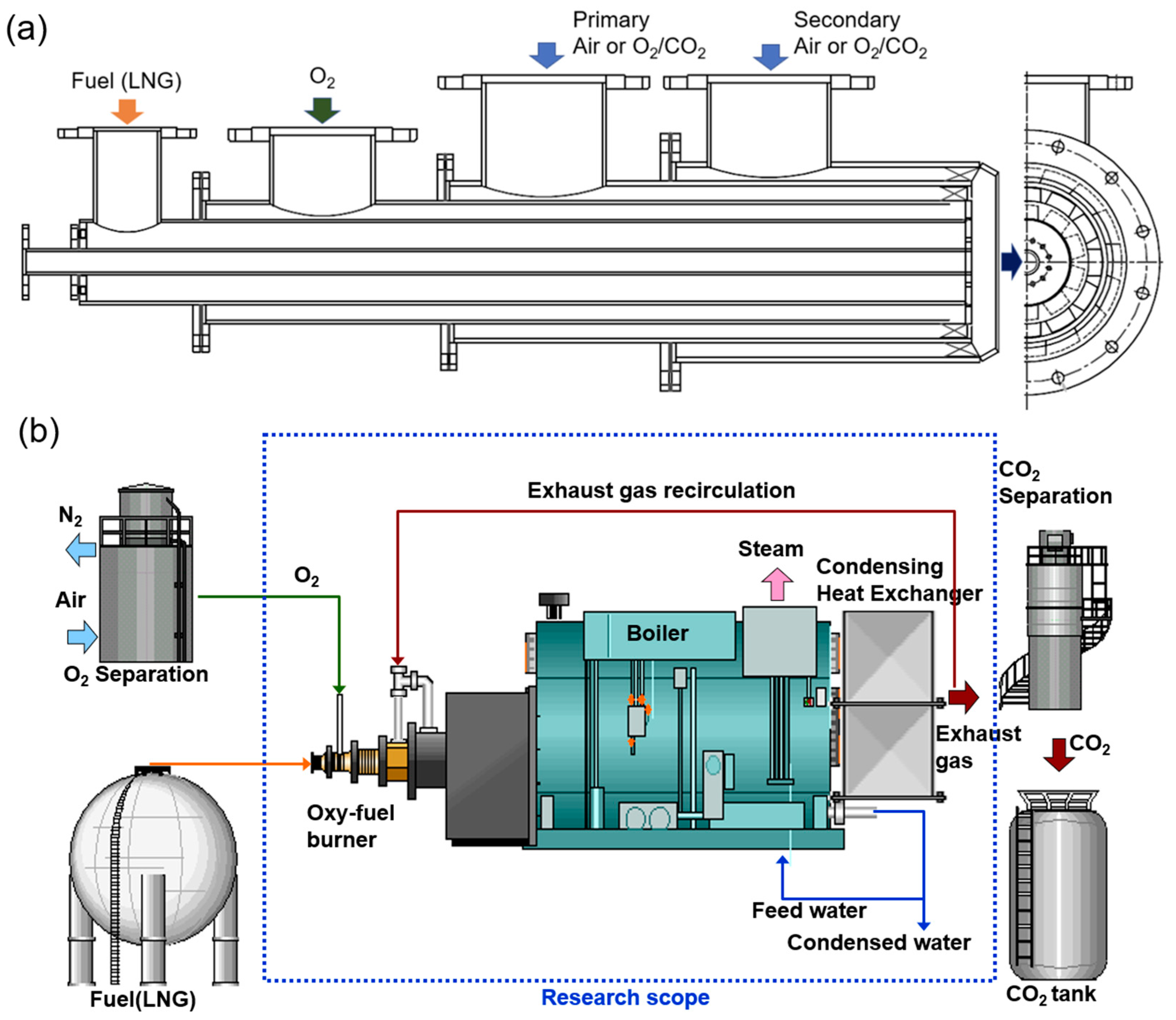
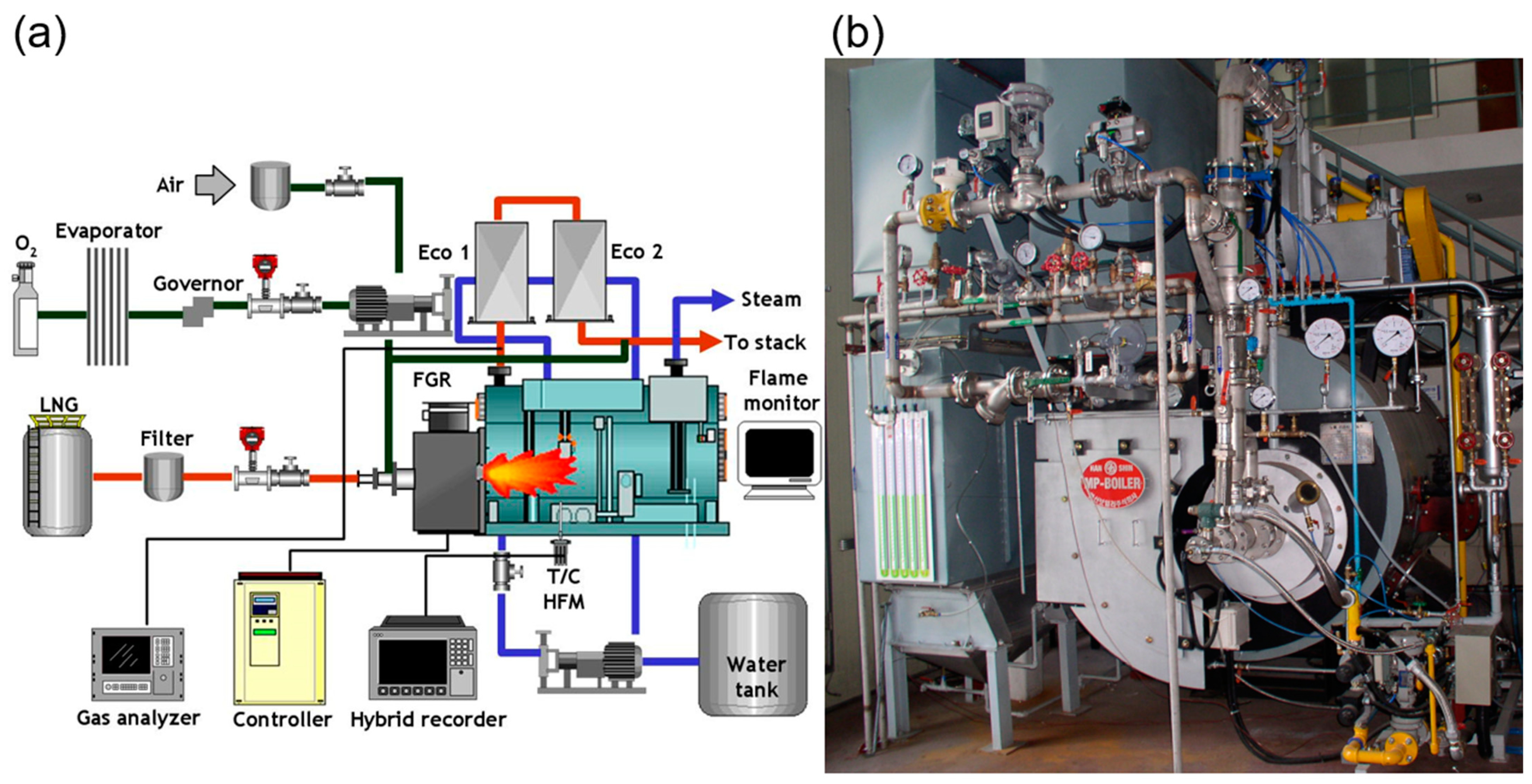

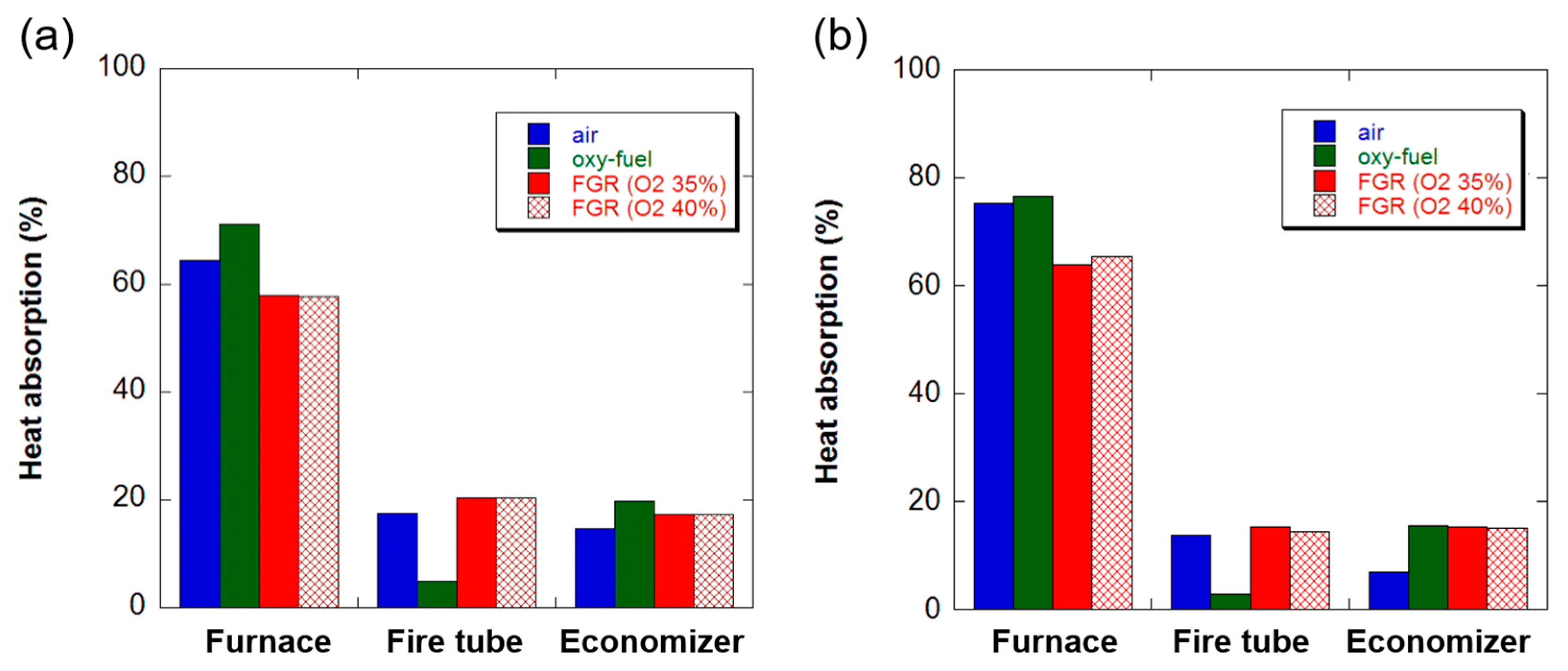


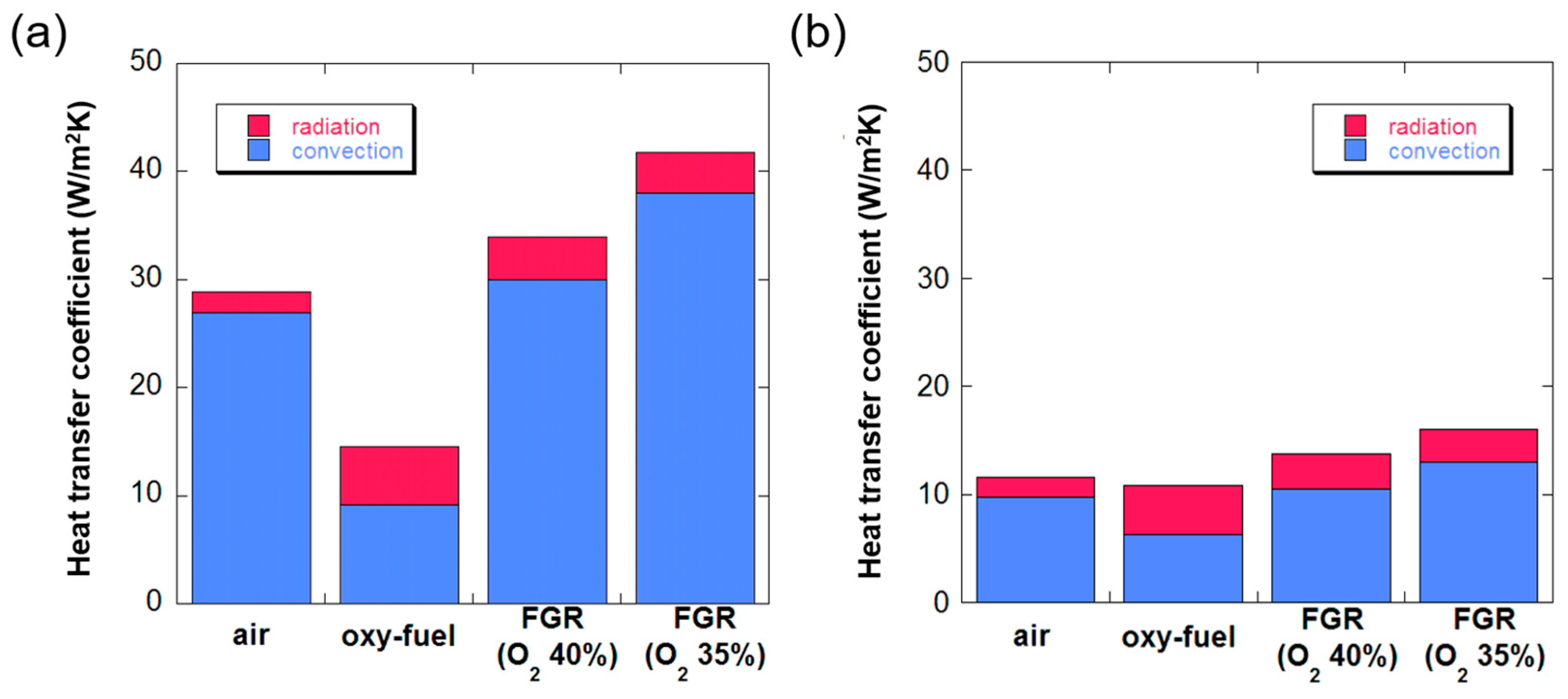



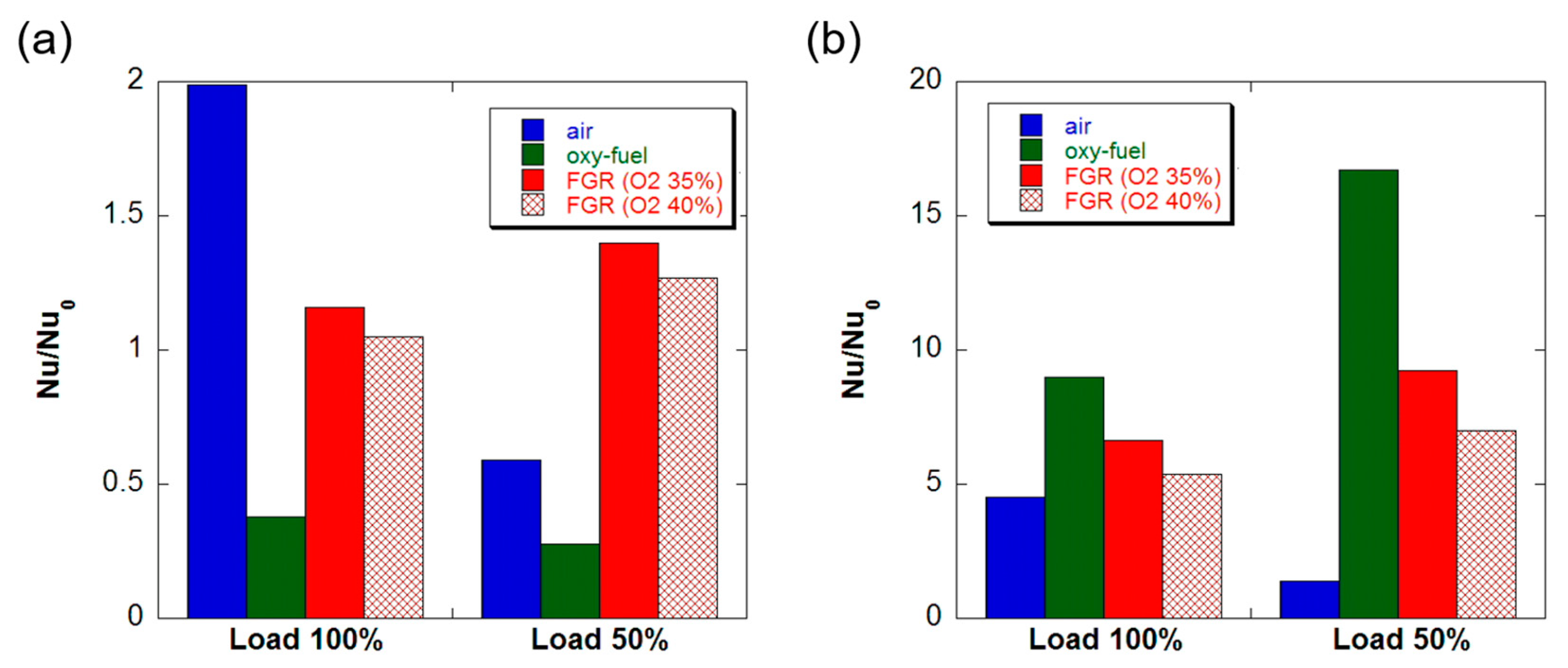
Disclaimer/Publisher’s Note: The statements, opinions and data contained in all publications are solely those of the individual author(s) and contributor(s) and not of MDPI and/or the editor(s). MDPI and/or the editor(s) disclaim responsibility for any injury to people or property resulting from any ideas, methods, instructions or products referred to in the content. |
© 2024 by the author. Licensee MDPI, Basel, Switzerland. This article is an open access article distributed under the terms and conditions of the Creative Commons Attribution (CC BY) license (https://creativecommons.org/licenses/by/4.0/).
Share and Cite
Ahn, J. Heat Transfer and Thermal Efficiency in Oxy-Fuel Retrofit of 0.5 MW Fire Tube Gas Boiler. Processes 2024, 12, 959. https://doi.org/10.3390/pr12050959
Ahn J. Heat Transfer and Thermal Efficiency in Oxy-Fuel Retrofit of 0.5 MW Fire Tube Gas Boiler. Processes. 2024; 12(5):959. https://doi.org/10.3390/pr12050959
Chicago/Turabian StyleAhn, Joon. 2024. "Heat Transfer and Thermal Efficiency in Oxy-Fuel Retrofit of 0.5 MW Fire Tube Gas Boiler" Processes 12, no. 5: 959. https://doi.org/10.3390/pr12050959






